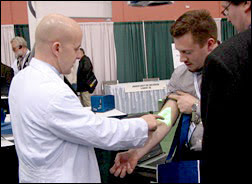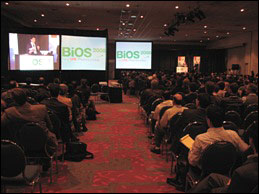
1300 Papers Presented at BiOS
SAN JOSE, Calif., Jan. 21, 2008 -- Biomedical optics took center stage at Photonics West this weekend as the BiOS 2008 conference began. Researchers from around the globe gathered in San Jose to attend a program this week that includes the presentation of 1300 papers documenting the latest clinical and technical advances in the fast-growing field.
Saturday, Jan. 19, included a presentation on a technique by Giuliano Scarcelli and Seok-Hyun Yun of Harvard Medical School that uses a Brillouin confocal microscope as a noninvasive way to monitor the density of a material as its properties change. Brillouin scattering is a process where photons are scattered in a material by acoustic vibrations (sound waves, or phonons). Scarcelli and Yun have used the technique with biological samples, such as monitoring the changes in a mouse eye lens in situ to see age-related density changes.
Luminetx Director of Clinical Operations David Pennington demonstrates the VeinViewer, a tool that enables technicians to find veins for easier IV insertion, during the BiOS 2008 exhibition. Luminetx Corp. is based in Memphis, Tenn. (Photo courtesy SPIE)
A paper on the latest applications for two-focus fluorescence correlation spectroscopy detailed work by Thomas Dertinger of the University of California, Los Angeles, et al. Dertinger and his fellow researchers wanted to measure the diffusion coefficient of molecules (in this case in an isotropic liquid) and its dependence on the state of the molecules. Standard fluorescence microscopy techniques suffer from potential errors introduced by aberrations of the optical system, and size and shape of the optical focal spot, which is critical in measuring the diffusion, depends on the index of the material which varies with temperature.
Dertinger's team used a laser confocal microscope arrangement with a dual laser source of orthogonal polarization, combined the source beams with a polarization beamsplitter and separated them with a polarization wedge at the sample. The two spots were then separate by a known amount (in this case approximately 400 nm) that provided a known size calibration of the sample area. In addition they implemented both auto- and cross-correlation algorithms to accurately extract the diffusion coefficient from the measured data.
The application of adaptive optics (AO) to optical coherence tomography (OCT) for in vivo imaging of healthy and diseased retinas was the subject of a paper by Robert J. Zawadzki of the University of California/Davis Medical Center, et al. Using adaptive optics with optical coherence tomography is improving the resolution of the instrument to see 3-µm structures in the retina. A dual AO system is employed in the sample arm of the OCT instrument; one AO mirror system addresses low order aberrations while the second corrects for the higher order aberrations of the optical train (including the lens of the eye). The description of the AO system will be covered in a talk during the MEMS conference on adaptive optics.
Research by Wonshik Choi and Michael S. Feld of the Massachusetts Institute of Technology was presented in a paper on tomographic phase microscopy. Biological cell material is very hard to see because the index of refraction of the material is all very similar and close to that of water. Using phase contrast enhances the optical phase difference as light travels through the material, but the phase contrast microscope doesn't give quantitative results, it only improves the image.
Choi and Feld sought to build a quantitative phase microscope that could produce a real-time, 3-D map of the index of the material in a living cell with enough resolution to differentiate the different materials in the cell. Doing it in real time allows researchers to see changes in the cell under varying conditions. They applied techniques used for x-ray computed tomography -- where the imaging system is rotated around the patient -- in the optical regime by analyzing the interference fringes at multiple angles using rotating mirrors to tilt the beam before it passes through the sample. They have been able to extend their technique to high speed and are now performing video rate optical tomography for cellular samples and show they can monitor the changes in a living cell as it is exposed to different chemicals.

The Hot Topics session during Photonics West's Biomedical Optics (BiOS) symposia always draws a standing-room-only crowd. (Photos courtesy SPIE)
During the BiOS Hot Topics session on Saturday night, a full-house crowd heard a series of expert reports that moderator Sergio Fantini of Tufts University characterized as "important advancements in medical treatments and diagnostics being made by the field of biomedical optics."
Among the highlights:
- R. Rox Anderson, Wellman Center for Photomedicine, Massachusetts General Hospital and Harvard School of Medicine, said that a deeper version of laser-guided fractional microbeam surgery methods now used in ophthalmology and dermatology provides a new paradigm for treatment of more deadly cancers; he also described the potential of low-light laser therapy in treating and preventing stroke damage.
- Bruce Tromberg, Beckman Laser Institute and Medical Clinic, University of California Irvine, and Lihong Wang, Washington University in St. Louis, showed impressive positive impacts on the success of therapy as a result of enhanced data gathered during treatment by diffuse optical imaging at Beckman and by photoacoustic tomography and microscopy at Washington University.
- David Piston, Vanderbilt University, described real-time quantitative microscopy at the nanometer scale that enables more focused therapies, and Mary-Ann Mycek, University of Michigan, showed how tissue optical spectroscopy is used in earlier, more accurate diagnosis and treatment of pancreatic disease.
- Paul French, Imperial College, talked about work in fluorescence lifetime imaging that has been revolutionized by the supercontinuum source technology.
- W. E. Moerner, Stanford University, described single-molecule superresolution imaging and trapping to control molecular activity, and Stefan Andersson-Engels, Lund University, reported on fiber-optic treatments for prostate and other cancers with considerably greater tissue penetration than current photodynamic therapies.
During the two-day Biomedical Optics exhibition, 150 companies displayed their latest products, components, and systems and gave BiOS conference attendees a focused look at the technologies aligned with their work.
For more information, visit: http://spie.org/pw
/Buyers_Guide/SPIE/c14069